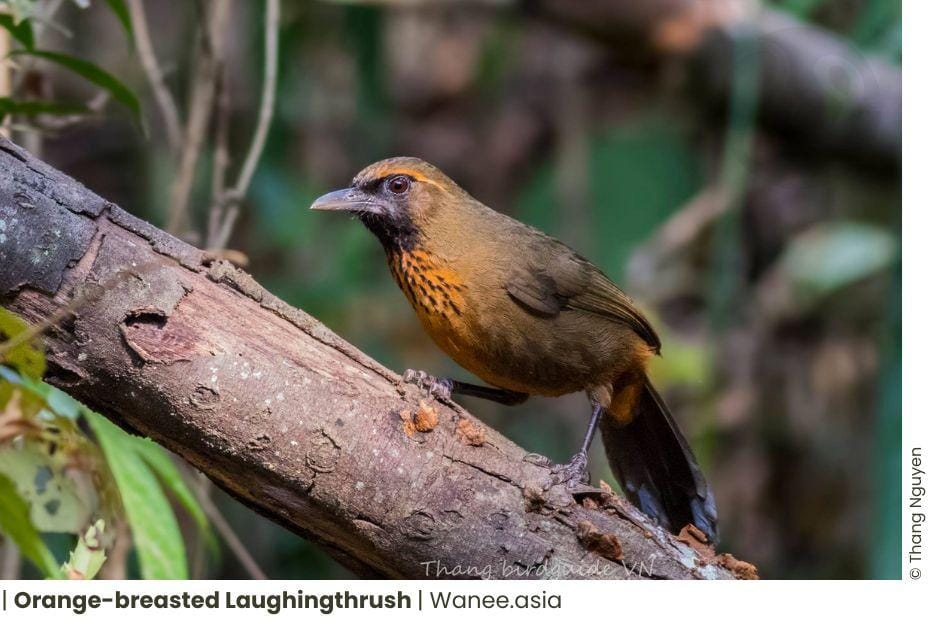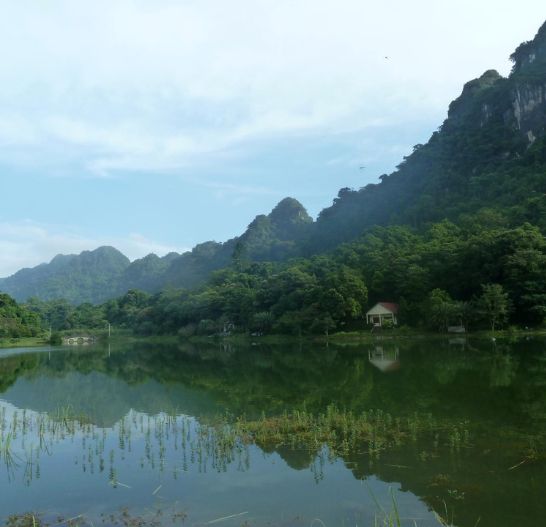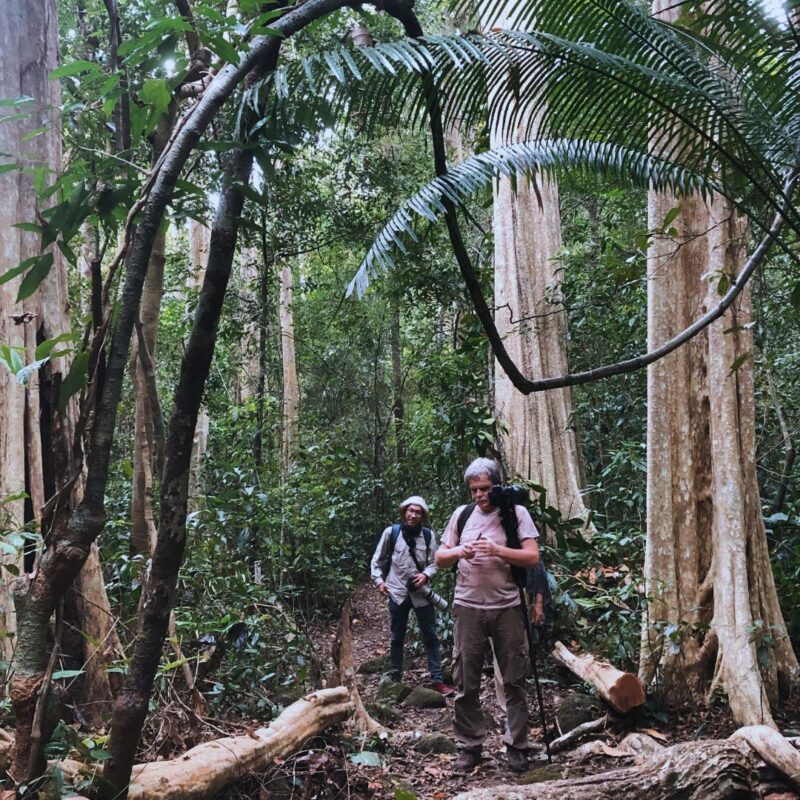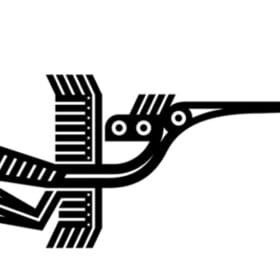This article will review all the information on birds of Vietnam, this may help you to arrange Vietnam birding or Vietnam Bird photography tour
Vietnam is home to 19 endemic species [1], more than any other country on the Southeast Asian mainland—along with 39 near-endemic species and many unique subspecies, making Vietnam a must-visit destination for bird enthusiasts and a growing hotspot for birding.
While Vietnam does not have the official national bird, “Chim Lạc” (Lac bird) is widely considered as an imaginary national bird, embraced by a majority of Vietnamese people
Overview birds of Vietnam
Vietnam’s bird diversity includes:
| TOTAL | 831 (24th) | Breeding Endemic | 10 |
| Landbirds | 672 | Seabirds | 25 |
| Migratory | 322 | Waterbirds | 154 |
For Clements Checklist update for 2021 includes:
Number of species: 963
Number of endemics: 19
Number of globally threatened species: 63
Number of introduced species: 5
Download Birds of Vietnam Checklist update 30/8/2022 by Avibase
IUCN Red List (open on new tab) Status for Vietnam Birds

Source: datazone.birdlife.org/ 10/2022
Read more: Vietnam Red Data Book & IUCN red list
What are the endemic and specialties birds of Vietnam?
Ten true endemic birds of Vietnam
Tonkin Partridge (Arborophila tonkinesis) – LC
Distributes from Northern Central to East Tonkin, this species was being complicated in taxonomy. Arborophila charltonii, A. tonkinensis, and A. graydoni (del Hoyo and Collar 2014) were previously lumped as A. charltonii following Sibley and Monroe (1990, 1993).
Edward’s Pheasant (Lophura edwardsi) – CR
Formerly distributed from Ha Tinh, Quang Binh, Quang Tri & Thua Thien Hue provinces and considered as locally fairly common. However, recently there was no sighting, probably more than 20 years.
Vietnamese Pheasant (Lophura hatinhensis) – unrecognised, was previous split from L. edwardsi following Sibley and Monroe (1990, 1993) but now is lumped back.
Imperial Pheasant (Lophura imperialis) – unrecognised, a study suggested this species is actually a hybrid between Vietnamese Pheasant x Silver Pheasant.
Black-crowned Fulvetta (Alcippe klossi) – LC
A split from Rufous-winged confined to south Annam. Fairly common and easy to see on Langbian and Bidoup moutains
White-throated Wren-Babbler (Rimator pasquieri) – EN
A recent split from Long-billed and confined to Mt Fan Si Pan in west Tonkin. It has also been recorded in recent years at Mu Cang Chai Species and Habitat Conservation Area: Yen Bai Province and Van Ban Nature Reserve (Lao Cai Province)
Orange-breasted Laughingthrush (Garrulax annamensis) – LC
Now split from Spot-breasted and endemic to south Annam. Locally common in Di Linh ad Da Lat.

Chestnut-eared Laughingthrush (Garrulax konkakinhensis) – VU
Only known from Mt Kon Ka Kinh in central Annam until it located and photographed it at Mang Canh in 2010, this place become a popular destination for birding nowadays.
Chestnut-eared Laughingthrush (Garrulax konkakinhensis) – VU
Only known from Mt Kon Ka Kinh in central Annam until it located and photographed it at Mang Canh in 2010, this place become a popular destination for birding nowadays.
Golden-winged Laughingthrush (Garrulax ngoclinhensis) – VU
So far only known from Mt Ngoc Linh in central Annam, Mang Ri forest near Tu Mo Rong is the most accessible site to see this species.
Collared Laughingthrush (Garrulax yersini) – EN
Only found in south Annam, centred round Mt Langbian, Bidoup Nui Ba national park and Chu Yang Sin national park
Grey-crowned Crocias (Crocias langbianis) – EN
New genus name is Laniellus, endemic to south Annam and very localized, it can be found at Ta Nung, Tuyen Lam and a site at Dam Rong on the road 28 Da Lat to Ban Me Thuot. Recently found in Mang Den and Ngoc Linh (Wildtour, 2014).
Vietnamese Greenfinch (Carduelis monguilloti) – LC
Confined to pine forest in south Annam, common in Da Lat and Di Linh
Near-endemic birds in Vietnam, meaning that they can be found near the border of Vietnam with its neighbor
White-eared Night-Heron (Gorsachius magnificus) – EN
Long believed to be endemic to southern China and once thought to breed only on Hainan Island, it was recently spot at a colony in Ba Be by western birders.
Orange-necked Partridge (Arborophila davidi) – NT
Used to be endemic to northeast Cochinchina, but recently found in eastern Cambodia. While it is now rarely seen in its former stronghold at Cat Tien National Park, Tan Pu Forest remains one of the most suitable sites to spot this species
Germain’s Peacock-Pheasant (Polyplectron germaini) – NT
Found in eastern Cambodia, but Vietnam is its stronghold, especially in Cat Tien National Park.
Red-vented Barbet (Megalaima lagrandieri) – LC
Found in Cambodia, Laos, and Vietnam, but it is usually easiest to spot in Vietnam.
Indochinese Barbet (Megalaima annamensis) – LC
Recently split from the Black-browed Barbet and is now confined to southern Laos and southern Vietnam.
Red-collared Woodpecker (Picus rabieri) – NT
Despite being found in Laos, Vietnam is the site to search for this bird. Surprisingly elusive for a Woodpecker, it has remained out of sight—just as it does in most tour groups.
Blue-rumped Pitta (Pitta soror) – LC
Although reportedly widespread from Indochina to western Thailand, this species is rarely seen outside Vietnam (and often missed even within the country).
Bar-bellied Pitta (Pitta elliotii) – LC
Like the Blue-rumped Pitta, this species is rarely seen outside of Vietnam, despite its range as far west as Thailand.
White-winged Magpie (Urocissa whiteheadi) – LC
Fairly widespread but rarely seen outside of Vietnam or southwest China.
Grey-crowned Tit (Aegithalos annamensis) – LC
Confined to southern Laos and Annamite range, this species is now widely recognized as distinct from the Black-throated Tit.
Yellow-billed Nuthatch (Sitta solangiae) – NT
Although this species is found outside of Vietnam, it is mostly seen within the country.
Limestone Warbler (Phylloscopus calciatilis) – LC
While found in limestone regions of central Laos and central Annam, Vietnam is the best site to spot it. Recently, this species was recently split from the Sulphur-breasted Warbler.
Black-headed Parrotbill (Paradoxornis margaritae) – NT
Now recognized as distinct from the Grey-headed, this species is confined to southern Annam, but rare in Mondulkiri, Cambodia.
Black-hooded Laughingthrush (Garrulax milleti) – NT
Barely extends into Laos but is otherwise restricted to Vietnam.
Rufous-cheeked Laughingthrush (Garrulax castanotis) – LC
While found on Hainan Island and in central Laos, the most reliable spots to see this species are in Vietnam, particularly at Mount Ba V and the forests along the western Ho Chi Minh Road at Sa Mu Pass.
White-cheeked Laughingthrush (Garrulax vassali) – LC
Fairly widespread in the highland of Laos and Vietnam.
Short-tailed Scimitar-Babbler (Jabouilleia danjoui) – NT
Virtually confined to Annam and Tonkin, this species, also known as the Indochinese Wren-Babbler, is a key target in Da Lat, Mang Den, and Bach Ma in Vietnam.
Sooty Babbler (Stachyris herberti) – LC
Once thought to be endemic to the limestone regions of central Laos,but now known to be thriving in central Annam, it is locally common in Phong Nha-Ke Bang National Park.
Pale-throated Wren Babbler (Spelaeornis kinneari) – NT
Confined to Mount Fansipan, this species was recently recorded in northwest Guangxi, Yunnan, China.
Grey-faced Tit-Babbler (Macronous kelleyi) – LC
An exciting Indochinese endemic, this species is very common and widespread in southern Vietnam.
Vietnamese Cutia (Cutia legalleni) – NT
Now split from the Himalayan Cutia and confined to southern Annam, it is common in Da Lat, Di Linh, Mang Den, and central Laos.
Black-crowned Barwing (Actinodura sodangoram) – LC
Only recently described and confined to southeastern Laos and south-central Annam, the best site to spit is in Mang Ri Forest, but it can also be seen by the roadside at Lo Xo Pass.
Indochinese Fulvetta (Alcippe danisi) – LC
A Laos specialty, but also found in central and southern Annam and seen on Bidoup Mountain and Ngọc Linh Mountain, above 1,800m.
New endemic species by recently split
Dalat Shrike Babbler (Pteruthius flaviscapis)
Possible endemisms in the future
These are local subspecies only found in Da Lat plateau:
- Blue-winged Minla (Minla cyanouroptera orientalis)
- Rufous-backed Sibia (Heterophasia annectens eximia)
- Black-throated Sunbird (Aethopyga saturata johnsi)
- Red Crossbill (Loxia curvirostra meridionalis)
- Brown Bullfinch Pyrrhula nipalensis ssp
How is Birding & Where to watch birds in Vietnam?
As known for a friendly and beautiful country, Vietnam is home to over 850 recorded species and has the highest number of endemic birds in Southeast Asia. The country’s biodiversity making it ideal place for birders when the mountain ranges have created unique habitats, making several birds only found in certain areas.
For those interested in short-term birding, Cat Tien National Park in the south is a great choice. The Mekong delta region also offers several birding spots, such as Tram Chim Wetland Reserve, Tien Giang or Ben Tre province’s muddy beaches. These sanctuaries are ideal for waterbirds and waders during migration season. Or else if you want to go somewhere cooler, Dalat plateau in the central highland will be ideal for you to enjoy beautiful landscapes and birding.
Unlike the Dalat plateau, Yok Don National Park, also in the central highland, has different kinds of habitat, including deciduous deptrocarp forest, and the Serepok river, home to the Mekong Wagtail. Kon Tum plateau also offers great opportunities for birding, with the Chestnut-eared Laughingthrush, Golden-winged Laughingthrush, and Black-crowned Barwing. The road between Kon Tum and Quang Nam provinces near Ngoc Linh Mountain provides access to Golden-winged Laughingthrush for birders at Mang Ri and Ngoc Lay, while Mang Den is a good spot to find the Chestnut-eared Laughingthrush.
For lowland Annamite provinces, there are also good birding spots near Hue city, Da Nang. While Bach Ma National Park is one of the best birding spots in Vietnam, Phong Nha–Ke Bang National Park in the north offers a great limestone forest and caves with unique bird species, such as Sooty Babbler and Limestone Leaf-warbler.
In the north, there are several great birding sites near Ha Noi, including Tam Dao National Park, just a 1.5-hour drive from Noi Bai airport, and Ba Vi Mountain. You can spot the Red-collared Woodpecker in the evergreen forests at Cuc Phuong National Park . For those interested in Sino-Himalayan avifauna, the Sa Pa – Fansipan region is a must-visit, and Ba Be National Park is a great spot to see the White-eared Night-heron.
Read more about: birds of Vietnam field guide, Cat Tien National Park Best Place for birdwatching in Vietnam
When is the best time for birding in Vietnam
There is not really a right or wrong time to birding in Vietnam as during most months of the year. Depending on your time and weather summary for each part of the country you will find a good place to enjoy your birding or bird-photography tour.
Whilst Vietnam is typically warm and humid, the weather can vary significantly from one region to another due to the country’s length. At times there has been snow (yes white snow!) in the mountainous far north whilst the beaches in the south enjoyed 32 °C and sunshine. So Vietnam weather for birding, we can be divided into 3 different regions based on administrative positions.
North-Vietnam weather for birding
Sa Pa, Ba Be Np., Tam Dao Np., Ba Vi Np., Xuan Thuy Np., Cuc Phuong Np,.
The north of Vietnam has distinct winter and summer seasons. The cool but mostly dry winter lasts from November to April when the temperatures average 17-220 C with the coldest months ranging from January – March. The summer lasts from May to October when it’s hot and humid with highest rainfall, making July – September the wettest month of the year.
The best time for birding in the North-Vietnam is during the dry season from Oct to Apr, and warm-clothing is recommended from Dec to Jan when it’s cold and cloudy.

Central-Vietnam weather for birding
Phong Nha-Ke Bang Np., Samu pass, Bach Ma Np,. Da Nang, Ngoc Linh Np., Kon-tum Pr.,
The weather in central of Vietnam is hot and dry weather from mid-January to late August, with the temperature often reaching 300 C. During the winter time, the rainfall increases within October to November. Achieving peak levels, it can occasionally be in the form of typhoons. Meanwhile, the central highland, its rainy season is from June to October and the peak of rainfall is often from July to September.
The far south of Central-Vietnam where is known for a longer dry season (January to September), with high temperature and little rain. The rainy season runs from October to Mid of December with almost haft the annual rainfall in the October – November period.
The best time for birding in the Central-Vietnam is from December to May. However, some places are still good for birding even during the rainy season from May to October. For example, in Son Tra, Da Nang, usually has short rain showers, and birding conditions improve right after the rain.

South-Vietnam weather for birding
Dalat plateau, Cat Tien Np., Dinh Mountain, Can Gio mangrove forest, Mekong delta
The southern region has a fairly constant temperature year-round (between 25 – 35°C) and experiences two main seasons: the dry and wet seasons. The dry season begins in November and ends in April or early May, with temperatures rising and humidity increasing from late February to May. The wet season is in the May – November period, with the heaviest rainfall occurring between June and August. During this time, rain often comes in short but intense afternoon downpours.
For Dalat, it rains from June to October, making outdoor pursuits problematic. From November to May, it is dryer with cold weather between December and January. For the Mekong Delta, it has a monsoon climate with two distinct seasons: the wet season from late July to late October and the dry season from November to July.
While you can birding for the whole years in the south of Vietnam, the best time for bird-watching and bird-photography in Cat Tien Np. and Dalat is from November to July. For Birding in Can Gio, it is from December to March when it is in the wintering time of shorebirds.
Explore Birding Tour in Cat Tien Np. & Dalat Plateau here!

Some common question about Vietnam Birds
What is the national birds of Vietnam?

What is the national birds of Vietnam?
Vietnam does not have the official national bird, but “Chim Lạc” (Lac bird) is considered as an imaginary national bird, supported by a majority of Vietnamese people, according to ancient documents and records. “Chim Lạc” is the symbol of Au Lac, the very first state of the ancient Vietnamese people in present-day North and North Central regions.
This imaginary Vietnamese national bird is a mysterious bird featuring outstretched wings with a long beak, which appears on the surfaces of ancient bronze drums, typically on the Dong Son Drum, resembling the bronze crane at the Temple of Literature in Hanoi. This “species” of bird in Vietnam is regarded as the totem of Lac Viet people (the ancient Vietnamese), which represents the wet rice civilization of the ancient Vietnamese. Chim lac is a symbol which is both familiar with people but also very sacred. The posture of a bird spreading its wings widely to fly on the sky with a straight beak and hold its head up symbolizes the longing aspiration and the dream of conquering challenges despite heavy storms ahead.
Does Vietnam have parrots?
Many, Vietnam has 10 species of Parrots: Ashy-throated Parrotbill, Black-headed Parrotbill, Black-throated Parrotbill, Golden Parrotbill, Grey-headed Parrotbill, Pin-tailed Parrotfinch, Short-tailed Parrotbill, Spot-breasted Parrotbill, Vernal Hanging Parrot, Vinous-throated Parrotbill
Are there pelicans in Vietnam?
Only Spot-billed Pelican occurs in the Mekong Delta, Southeast, and Red River Delta in Vietnam.
References
[1] Avibase – Bird Checklists of the World – Vietnam – https://avibase.bsc-eoc.org/ 2022
[2] Vietnam Birds – A Natural online field guide – WANEE teams – https://wanee.asia/vietnam-birds-a-naturalist-online-guide-up-date-2023/ Jan/2023



